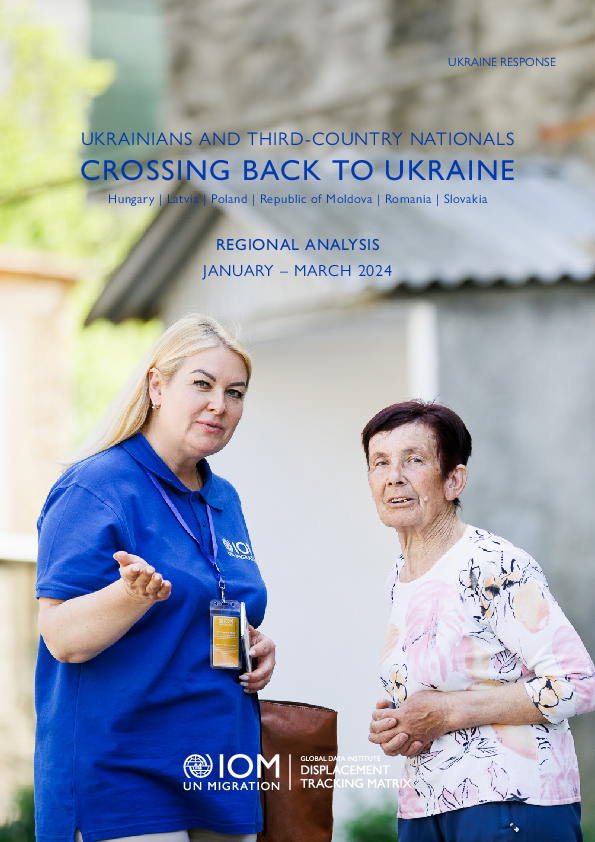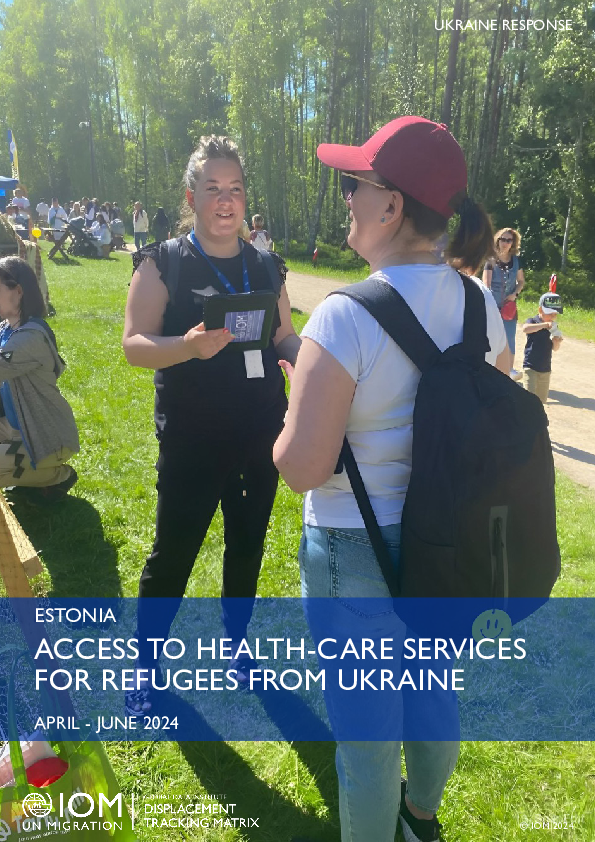-
Countries
-
Data and Analysis
-
Special Focus
-
Crisis Responses
Ukraine Response
Feb 07 2023
Print
Since the start of the war in Ukraine in February 2022, IOM has worked to provide direct assistance to affected populations but has also provided a better understanding of these individuals’ situations, aiming at improving and consolidating the crisis response efforts undertaken by IOM, governments, and the international community.
IOM’s Displacement Tracking Matrix (DTM) programme seeks to understand where affected people are, their most urgent needs, and their intentions for the coming period. IOM has conducted surveys across Ukraine and the region, providing crucial insights to inform evidence-based humanitarian actions and policy.
Inside Ukraine, IOM has implemented consecutive rounds of representative general population survey since March 2022, tracking internal displacement and mobility flows. This survey gathers insights into the situation and needs of vulnerable population groups across thematic areas, applying intersectoral approach to collect information. IOM has also built a field presence and a network of key informants across 20 regions of Ukraine and the capital city, monitoring the recorded presence of IDPs at municipality level through regular baseline assessments.
Furthermore, IOM has conducted a number of studies in neighbouring to Ukraine countries: Belarus, Republic of Moldova, Romania, Hungary, Poland, and Slovakia to survey the needs and intentions of those fleeing from the war and those crossing back to Ukraine. In addition to this, IOM has enlarged the scope of the DTM tool to assess the situation concerning Ukrainian refugees and Third-Country Nationals (TCNs) that continued their onwards journey and reached further destinations in Europe: Czechia, the Baltics, Western Balkans as well as Belgium, Germany, and France.
Through IOM’s assessments, governments and the humanitarian community are able to quickly identify the needs, movements, and intentions of affected persons and to further consolidate humanitarian interventions in support of the internally displaced populations in Ukraine, and the Ukrainian refugees and TCNs fleeing from war to other countries in Europe
Countries in this response
- Active DTM operation
- Past DTM operation
Check out the interactive dashboard
Ukraine Regional Response: Needs, Intentions, and Border Crossings
Check out the interactive dashboard
Registered IDP Area Baseline Assessment Dashboard (ABA)
Sweden — Temporary Protection Holders in Sweden — Intentions, Needs and Challenges (April-May 2024)
In 2023, IOM was commissioned by the Swedish Government to carry out a survey that offered an overview of the living conditions, intentions, needs, and integration challenges of displaced persons from Ukraine who were in Sweden at the beginning of the second year of implementation of the temporar
Sweden — Temporary Protection Holders in Sweden — Executive Summary SWE/ENG (April-May 2024)
This is the Executive Summary in Swedish and English of the full report available at this link.
Україна — Огляд житлової ситуації в Україні: Умови проживання, вартість оренди та фактори мобільності (липень 2024)
Внаслідок повномасштабного вторгнення Російської Федерації в Україну в лютому 2022 року понад два мільйони одиниць житла було пошкоджено або зруйновано.
Ukraine — Conditions of Return Assessment Factsheet — Round 8 (July 2024)
The Conditions of Return Assessment (CoRA) provides granular and actionable data on the conditions of returns in Ukraine, using a multisectoral location-level assessment (MSLA) methodology conducted with local authority key informants in areas of return across Ukraine.
Україна — ПРОФІЛІ ОБЛАСТЕЙ — Опитування загального населення Раунд 16 (липень 2024)
Профілі областей ґрунтуються на даних раунду 16 Опитування загального населення МОМ, з акцентом на демографічних показниках і переміщенні населення, довгострокових рішеннях, достатності житла, базових потребах, зайнятості та доходах, а також соціальній згуртованості.
Ukraine — Pathways for Regular Migration: Perceptions of Migrant Workers and Recovery in Ukraine — July 2024
Pathways for regular migration are an essential component of Ukraine’s recovery, addressing labour shortages and demographic challenges.
Ukraine Response — Regional Analysis — Ukrainians and TCNs Crossing Back to Ukraine (January - March 2024)
This report presents evidence on persons crossing back to Ukraine from abroad distinguishing between those who aim to remain in the country for longer periods and those who plan to pay a short visit.
Ukraine — Housing Brief: Living conditions, rental costs and mobility factors —July 2024
As a result of the full-scale invasion of Ukraine by the Russian Federation in February 2022, more than two million housing units were damaged or destroyed.
Ukraine Response — Regional Analysis — Access to Housing for Refugees from Ukraine (January - March 2024)
IOM’s Displacement Tracking Matrix collected data through Surveys with Refugees in the Ukraine Response region from January to March 2024 in nine countries in Central and Eastern Europe: Czechia,1 Estonia, Hungary, Latvia, Lithuania, Poland,2 Romania, R
Estonia — Access to Healthcare Services for Refugees from Ukraine (April - June 2024)
The IOM’s Displacement Tracking Matrix (DTM) collected data through Surveys with refugees in the Ukraine Response region from April to June 2024, conducting interviews with a total of 654 individuals in Estonia.
Estonia — Labour Market Integration of Refugees from Ukraine (April - June 2024)
The IOM’s Displacement Tracking Matrix (DTM) collected data through Surveys with Refugees in the Ukraine Response region from April to June 2024. In Estonia, a total of 654 surveys were collected.
Ukraine — Oblast Profiles — General Population Survey Round 16 (July 2024)
The Oblast Profiles draw from data collected during Round 16 of IOM Ukraine’s General Population Survey (GPS), with an emphasis on demographics & displacement, the adoption of coping strategies to meet needs, employment & income, and housing.
Pagination
Ukraine — Area Baseline Assessment — Round 36
Jul 11 2024
<p><strong>Kharkivska (388,118), Dnipropetrovska (373,301), and Kyivska (259,568) Oblasts</strong> have the highest numbers of officially registered IDPs.&nbsp;</p>
Ukraine — Area Baseline Assessment — Round 35
Jul 11 2024
<p><strong>Kharkivska (384,897), Dnipropetrovska (377,837), and Kyivska (300,080) Oblasts</strong> have the highest numbers of officially registered IDPs.&nbsp;</p>
Ukraine — Conditions of Return Assessment Dataset — Round 7 (Feb-Mar 2024)
May 10 2024
<p>The Conditions of Return Assessment is a tool designed to measure the population and severity of conditions in locations of return. The assessment is based on 20 indicators divided into 5 ‘drivers’: (1) livelihoods, (2) utilities and services (3) residential destruction, (4) Safety and…
Ukraine — Mobility and Needs Assessment — Round 7 (March 2024)
Apr 29 2024
<p>IOM's Data and Analytics (D&amp;A) Unit developed the Mobility and Needs Assessment (MaNA), a monthly, multi-sectoral assessment designed to systematically monitor the estimated current presence of key population groups, including de facto Internally Displaced Persons (IDPs),…
Ukraine — Area Baseline Assessment — Round 34
Apr 17 2024
<p>The data collected for the Area Baseline Assessment Round 34 reflects the&nbsp;up-to-date local administrative register of the IDP population as of 31 March 2024, equivalent to a total of <strong>3,387,291 </strong>registered IDPs. Registered IDP figures were collected for…
Ukraine — Mobility and Needs Assessment — Round 6 (February 2024)
Apr 08 2024
<p>IOM's Data and Analytics (D&amp;A) Unit developed the Mobility and Needs Assessment (MaNA), a monthly, multi-sectoral assessment designed to systematically monitor the estimated current presence of key population groups, including de facto Internally Displaced Persons (IDPs),…
Ukraine — Mobility and Needs Assessment — Round 1 (Jul-Aug 2023)
Mar 21 2024
<p>During this round of data collection, IOM Ukraine's Data &amp; Analytics Unit conducted assessments in 85 hromadas across 50 raions and 20 oblasts. &nbsp;Assessed hromadas were selected based on their relevance to humanitarian and recovery programming, pre-war population size…
Ukraine — Conditions of Return Assessment Dataset — Round 6 (Nov-Dec 2023)
Mar 21 2024
<p>The Conditions of Return Assessment is a tool designed to measure the population and severity of conditions in locations of return. The assessment is based on 20 indicators divided into 5 ‘drivers’: (1) livelihoods, (2) utilities and services (3) residential destruction, (4) Safety and…
Ukraine — Area Baseline Assessment — Round 33
Mar 19 2024
<p>The data collected for the Area Baseline Assessment Round 33 reflects the&nbsp;up-to-date local administrative register of the IDP population as of 29 February 2024, equivalent to a total of <strong>3,413,472 </strong>registered IDPs. Registered IDP figures were collected…
Ukraine — Area Baseline Assessment — Round 32
Mar 19 2024
<p>The data collected for the Area Baseline Assessment Round 32 reflects the up-to-date local administrative register of the IDP population as of 31 January 2024, equivalent to a total of<strong> 3,509,147</strong> registered IDPs. Registered IDP figures were collected for 1,098…
Ukraine — Mobility and Needs Assessment — Round 5 (January 2024)
Mar 08 2024
<p>During this round of data collection, IOM Ukraine's Data &amp; Analytics Unit conducted assessments in <strong>253</strong> hromadas across 72 raions and 23 oblasts and Kyiv City. &nbsp;Assessed hromadas were selected based on their relevance to humanitarian and…
Ukraine — Mobility and Needs Assessment — Round 4 (December 2023)
Feb 07 2024
<p>During this round of data collection, IOM Ukraine's Data &amp; Analytics Unit conducted assessments in <strong>253 hromadas</strong> across 70 raions and 23 oblasts and Kyiv City. &nbsp;Assessed hromadas were selected based on their relevance to humanitarian and…
Ukraine — Area Baseline Assessment — Round 31
Jan 16 2024
<p>The data collected for the Area Baseline Assessment Round 31 reflects the up-to-date local administrative register of the IDP population as of 31 December 2023, equivalent to a total of <strong>3,522,045 registered IDPs</strong>. Registered IDP figures were collected for <…
Ukraine — Mobility and Needs Assessment — Round 3 (November 2023)
Dec 24 2023
<p>IOM's Data and Analytics (D&amp;A) Unit developed the Mobility and Needs Assessment (MaNA), a monthly, multi-sectoral assessment designed to systematically monitor the estimated current presence of key population groups, including de facto Internally Displaced Persons (IDPs),…
Ukraine — Conditions of Return Assessment Dataset — Round 5 (Sep-Oct 2023)
Dec 15 2023
<p>The overarching aim of the Conditions of Return Assessment (CoRA) is to facilitate the development, targeting, and monitoring of conditions that underpin humanitarian, recovery and stabilisation needs in areas of return across Ukraine, by providing: 1. a systematic evidence base updated on…
Ukraine — Area Baseline Assessment — Round 30
Dec 12 2023
<p>The data collected for the Area Baseline Assessment Round 30 reflects the up-to-date local administrative register of the IDP population as of 30 November 2023, equivalent to a total of 3,540,799 registered IDPs. Registered IDP figures were collected for 108 raions. Data disaggregated by…
Ukraine — Area Baseline Assessment (Hromada level) — Round 29
Nov 17 2023
The data collected for the Area Baseline Assessment Round 29 reflects the up-to-date local administrative register of the IDP population as of 31 October 2023, equivalent to a total of 3,527,731 registered IDPs recorded. Registered IDP figures were collected for 1,039 hromadas (78% of all hromadas…
Ukraine — Area Baseline Assessment (Raion level) — Round 29
Nov 17 2023
The data collected for the Area Baseline Assessment Round 29 reflects the up-to-date local administrative register of the IDP population as of 31 October 2023, equivalent to a total of 3,527,731 registered IDPs recorded. Registered IDP figures were collected for 1,039 hromadas (78% of all hromadas…
Ukraine — Area Baseline Assessment (Hromada level) — Round 28
Oct 24 2023
The data collected for the Area Baseline Assessment Round 28 reflects the up-to-date local administrative register of the IDP population as of 30 September 2023, equivalent to a total of 3,516,338 registered IDPs. Registered IDP figures were collected for 1,039 hromadas (78% of all hromadas covered…
Ukraine — Area Baseline Assessment (Raion level) — Round 28
Oct 24 2023
The data collected for the Area Baseline Assessment Round 28 reflects the up-to-date local administrative register of the IDP population as of 30 September 2023, equivalent to a total of 3,516,338 registered IDPs. Registered IDP figures were collected for 1,039 hromadas (78% of all hromadas covered…















